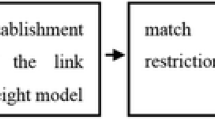Abstract
Detecting objects of interest from a video sequence is a fundamental and critical task in automated visual surveillance. Most current approaches only focus on discriminating moving objects by background subtraction whether or not the objects of interest can be moving or stationary. In this paper, we propose layers segmentation to detect both moving and stationary target objects from surveillance video. We extend the Maximum Entropy (ME) statistical model to segment layers with features, which are collected by constructing a codebook with a set of codewords for each pixel. We also indicate how the training models are used for the discrimination of target objects in surveillance video. Our experimental results are presented in terms of the success rate and the segmenting precision.
Similar content being viewed by others
References
Berger, A.L., Della Pietra, S.A., Della Pietra, V.J., 1996. A maximum entropy approach to natural language processing.Computational Linguistics,22(1):39–71.
Cucchiara, R., Grana, C., Piccardi, M., Prati, A., 2003. Detecting moving objects, ghosts and shadows in video streams.IEEE Trans. on Patt. Anal. and Machine Intell.,25(1):1337–1342.
Chalidabhongse, T.H., Kim, K., Harwood, D., Davis, L., 2003. A Perturbation Method for Evaluation Background Subtraction Algorithms. Joint IEEE International Workshop On Visual Surveillance and Performance Evaluation of Tracking and Surveillance.
Dick, A.R., Brooks, M.J., 2003. Issues in Automated Visual Surveillance. International Conference on Digital Image Computing: Techniques and Applications.
Elgammal, A., Harwood, D., Davis, L.S., 2000. Non-Parametric Model for Background Subtraction. European Conf. Computer Vision,2:751–767.
Hsu, W., Chang, S.F., Huang, C.W., Kennedy, L., Lin, C.Y., Lyengar, G., 2004. Discovery and Fusion of Salient Multi-modal Features towards News Story Segmentation. IS&T/SPIE Symposium on Electronic Imaging: Science and Technology-SPIE Storage and Retrieval of Image/Video Database.
Horprasert, T., Harwood, D., Davis, L.S., 1999. A Statistical Approach for Real-time Robust Background Subtraction and Shadow Detection. IEEE Frame-Rate Applications Workshop.
Horn, B.K.P., 1986. Robot Vision. The MIT Press, p. 66–69, 299–333.
Kim, K., Chalidabhongse, T.H., Harwood, D., Davis, L., 2004. Background Modeling and Subtraction by Codebook Construction. IEEE International Conference on Image Processing.
Lee, D.S., Hull, J.J., Erol, B., 2003. A Bayesian Framework for Gaussian Mixture Background Modelling. IEEE International Conference on Image Processing.
Porikli, F., Tuzel, O., 2003. Human Body Tracking by Adaptive Background Models and Mean-Shift Analysis. IEEE International Workshop on Performance Evaluation of Tracking and Surveillance.
Sen-Ching, S., Cheung, C.K., 2004. Robust Techniques for Background Subtraction in Urban Traffic Video. Proceedings of SPIE.
Stauffer, C., Grimson, W.E.L., 1999. Adaptive Background Mixture Models for Real-time Tracking. IEEE Int. Conf. Computer Vision and Pattern Recognition,2:246–252.
Author information
Authors and Affiliations
Corresponding author
Additional information
Project supported by the National Natural Science Foundation of China (No. 60272031), and Technology Plan Program of Zhejiang Province (No. 2003C21010), and Zhejiang Provincial Natural Science Foundation of China (No. M603202)
Rights and permissions
About this article
Cite this article
Qin, Lj., Zhuang, Yt., Pan, Yh. et al. Video segmentation using Maximum Entropy Model. J. Zheijang Univ.-Sci. 6 (Suppl 1), 47–52 (2005). https://doi.org/10.1631/jzus.2005.AS0047
Received:
Accepted:
Published:
Issue Date:
DOI: https://doi.org/10.1631/jzus.2005.AS0047




